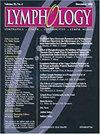局部他克莫司0.1%治疗皮肤微囊性淋巴畸形。
IF 0.7
4区 医学
Q4 IMMUNOLOGY
引用次数: 1
摘要
国际文献中描述的微囊性淋巴管畸形是胚胎发育不规则导致的低流量先天性血管畸形(VM)的一个亚组。微囊性病变通常表现为充满淋巴和血液的囊泡的积聚,当囊泡外化时,会导致皮肤浸渍,从而导致疼痛和潜在感染,从而损害患者的生活质量。对于这种类型的淋巴畸形的成功治疗,既没有标准化的算法,也没有明确的指导方针,所采用的治疗方案往往会导致矛盾和短暂的结果,复发率很高。他克莫司的局部制剂是一种著名的FDA批准的抗T细胞剂,最近被鉴定为ALK1的有效激活剂,ALK1参与包括血管生成在内的几个过程和功能。我们研究了他克莫司局部给药是否是直接靶向皮肤微囊性淋巴管畸形的有效治疗方法,作为全身治疗的补充。该研究招募了四名皮肤微囊性淋巴管畸形患者:三名男性(年龄:13、15、18岁)和一名女性(年龄:30岁)。其中两名患者背部出现病变,一名患者左手和一名患者左下肢出现病变。所有四名患者在之前选择的应用区域接受0.1%他克莫司的局部治疗,每天两次,持续10周。每周进行临床随访,同时密切医患联系。所有患者在治疗后均表现出满意的反应。所有病例均停止了淋巴溢血和出血,两名患者的病变美观程度有所改善。迄今为止,所有患者的病变大小或范围均未出现临床显著变化。局部他克莫司治疗微囊性淋巴管畸形是一种有前景且合理的选择。我们的研究结果鼓励在更大的人群中进行进一步的探索,并考虑到这是一种安全有效的替代或补充全身治疗的疗法。本文章由计算机程序翻译,如有差异,请以英文原文为准。
Topical Tacrolimus 0.1% for treatment of cutaneous microcystic lymphatic malformations.
Microcystic lymphatic malformations as described in the international literature form a subgroup of low-flow congenital vascular malformations (VM) resulting from irregular embryological development. Microcystic lesions normally manifest as an accumulation of lymph- and blood-filled vesicles that, when externalized, cause skin maceration with consequent pain and potential infection resulting in the impairment of the patient's quality of life. There is no consensus on a standardized algorithm nor clear guidelines for successful treatment of this type of lymphatic malformation, and treatment options employed often result in ambivalent and transient outcomes with a high rate of recurrence. The topical formulation of tacrolimus is a well-known FDAapproved anti-T cell agent that was recently identified as a potent activator of ALK1, which is involved in several processes and functions including angiogenesis. We investigated if topical administration of tacrolimus may be an effective therapy for directly targeting cutaneous microcystic lymphatic malformations as a complement to systemic treatment. The study enrolled four patients with cutaneous microcystic lymphatic malformations: three male (ages: 13,15,18) and one female (age: 30). Two of the patients presented lesions on their backs, one patient on the left hand and one on the left lower limb. All four patients received treatment with topical tacrolimus 0.1% twice a day for 10 weeks on a previously selected area for application. Weekly clinical follow-ups were conducted along with close physician-patient contact. All patients displayed a satisfactory response after treatment. Lymphorrhea and bleeding were stopped in all cases and the esthetic aspect of lesions improved in two patients. To date, all patients presented no clinically significant changes to the size or extension of the lesion. Topical tacrolimus treatment is a promising and reasonable option for microcystic lymphatic malformations. Our results encourage further exploration in larger populations with the consideration that it is a safe and effective alternative or complementary therapy to systemic treatment.
求助全文
通过发布文献求助,成功后即可免费获取论文全文。
去求助
来源期刊

Lymphology
医学-免疫学
CiteScore
5.20
自引率
8.00%
发文量
29
审稿时长
3 months
期刊介绍:
The Journal contains original articles, special features (see below), and information regarding the International Society of Lymphology. It seeks original papers dealing with clinical and basic studies of the lymphatic system and its disorders including related fields. Articles are accepted for external review and publication on the condition that they are contributed to Lymphology only and that no substantial part has been or will be published elsewhere.
 求助内容:
求助内容: 应助结果提醒方式:
应助结果提醒方式:


